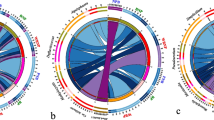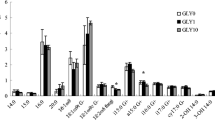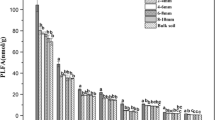Abstract
The biological control agent (BCA) Pseudomonas fluorescens DR54 was applied to seeds (experiment 1) or roots (experiment 2) of barley growing in microcosms, while noninoculated plants served as controls. The fate of the BCA and its effects on the rhizosphere microbial community was evaluated in microcosms destructively sampled at days 2, 4, 6, and 9 after inoculation. In both experiments the number of P. fluorescens DR54 cells decreased immediately after application as enumerated by immunostaining and microscope direct counting. Substrate-induced respiration (SIR) was taken as a measurement of the active microbial biomass, while indicators of the total microbiota (and main taxonomic groups) were obtained using the phospholipid fatty acid (PLFA) technique. In experiment 1, these parameters were unaffected by the relatively small number of BCA cells applied, whereas in experiment 2, the larger BCA input resulted in an enhanced level of both SIR and PLFAs from Gram-negative bacteria (which included the BCA itself). However, at day 9 after inoculation, treatments with P. fluorescens DR54 and controls were similar in all measured parameters in both experiments. This was also illustrated very clearly by principal component analysis of the PLFA data, which in both experiments were able to discriminate between treatments in the first days after BCA inoculation, thus confirming the sensitivity of this method. Laccase activity has a potential as an indicator of fungal stress, e.g., when challenged with an antifungal BCA. This seemed to be supported in experiment 2, where the activity of this enzyme was enhanced four-fold in the BCA treatment at day 2. Our study shows that under the present conditions, P. fluorescens DR54 disappears from the soil and causes only transient effects on the soil microbiota. It also shows that the PLFA technique is a sensitive and reliable monitoring tool in in situ assessment of BCA nontarget effect on indigenous microorganisms in soil.




Similar content being viewed by others

References
JPE Anderson KH Domsch (1978) ArticleTitleA physiological method for the quantitative measurement of microbial biomass in soils Soil Biol Biochem 10 215–221 Occurrence Handle10.1016/0038-0717(78)90099-8
JPE Anderson KH Domsch (1985) ArticleTitleMaintenance carbon requirements of actively-metabolizing populations under in situ conditions Soil Biol Biochem 17 197–203 Occurrence Handle10.1016/0038-0717(85)90115-4
PAHM Bakker DCM Glandorf M Viebahn TWM Ouwens E Smit P Leeflang K Wernar LS Thomashow JE Thomas-Oate LC Loon Particlevan (2002) ArticleTitleEffects of Pseudomonas putida modified to produce phenazine-1-carboxylic acid and 2,4-diacetylphloroglucinol on the microflora of field grown wheat A Van Leeuw J Microb 81 617–624 Occurrence Handle10.1023/A:1020526126283
DL Balkwill FR Leach JT Wilson JF McNabb DC White (1988) ArticleTitleEquivalence of microbial biomass measures based on membrane lipid and cell wall components, adenosine triphosphate, and direct counts in subsurface aquifer sediments Microb Ecol 16 73–84
AJ Bennet C Leifert JM Whipps (2003) ArticleTitleSurvival of the biocontrol agents Coniothyrium minitants and Bacillus subtilis MBI 600 introduced into pasteurised, sterilised and non-sterile soil Soil Biol Biochem 35 1565–1573 Occurrence Handle10.1016/j.soilbio.2003.08.001
GJ Boland LD Kuykendall (1998) Plant–Microbe Interactions and Biological Control Marcel Dekker New York
K Broglie R Broglie N Benhamou I Chet (1993) The role of cell wall degrading enzymes in fungal disease resistance I Chet (Eds) Biotechnology in Plant Disease Control Wiley-Liss New York 139–156
JD Crowe S Olsson (2001) ArticleTitleInduction of laccase activity in Rhizoctonia solani by antagonistic Pseudomonas fluorescens strains and a range of chemical treatments Appl Environ Microbiol 67 2088–2094 Occurrence Handle10.1128/AEM.67.5.2088-2094.2001 Occurrence Handle11319086
F Ekelund S Olsson A Johansen (2003) ArticleTitleChanges in the succession and diversity of protozoan and microbial populations in soil spiked with a range of copper concentrations Soil Biol Biochem 35 1507–1516 Occurrence Handle10.1016/S0038-0717(03)00249-9
TW Federle (1986) Microbial distribution in soil—new techniques F Meguar M Gantar (Eds) Perspectives in Microbial Biology Slovene Society for Microbiology Ljubljana, Slovenia 493–498
J Fernández-Larrea U Stahl (1996) ArticleTitleIsolation and characterization of a laccase gene from Podospora anserina Mol Gen Genet 252 539–551 Occurrence Handle10.1007/s004380050261 Occurrence Handle8914515
Å Frostegård A Tunlid E Bååth (1993) ArticleTitlePhospholipid fatty acid composition, biomass, and activity of microbial communities from two soil types experimentally exposed to different heavy metals Appl Environ Microbiol 59 3605–3617
JV Gagliardi JS Buyer JS Angle E Russek-Cohen (2001) ArticleTitleStructural and functional analysis of whole-soil microbial communities for risk and efficacy testing following microbial inoculation of wheat roots in diverse soils Soil Biol Biochem 33 25–40 Occurrence Handle10.1016/S0038-0717(00)00110-3
M Girlanda S Perotto Y Mönne-Loccoz R Bergero A Lazzari G Défago P Bonfante AM Luppi (2001) ArticleTitleImpact of biocontrol Pseudomonas fluorescens CHA0 and a genetically modified derivative on the diversity of culturable fungi in the cucumber rhizosphere Appl Environ Microbiol 67 1851–1864 Occurrence Handle10.1128/AEM.67.4.1851-1864.2001 Occurrence Handle11282643
DCM Glandorf P Verheggen T Jansen J-W Jorritsma E Smit E Leeflang K Wernars LS Thomashow E Laureijs JE Thomas-Oates PAHM Bakker LC Loon Particlevan (2001) ArticleTitleEffect of genetically modified Pseudomonas putida WCS358r on the fungal rhizosphere microflora of field-grown wheat Appl Environ Microbiol 67 3371–3378 Occurrence Handle10.1128/AEM.67.8.3371-3378.2001 Occurrence Handle11472906
BS Griffiths K Ritz N Ebblewhite E Paterson K Killham (1998) ArticleTitleRye grass rhizosphere microbial community structure under ambient and elevated CO2 concentrations, with observations on wheat rhizosphere Soil Biol Biochem 30 315–321 Occurrence Handle10.1016/S0038-0717(97)00133-8
BS Griffiths K Ritz N Ebblewhite G Dobson (1999) ArticleTitleSoil microbial community structure: effects of substrate loading rates Soil Biol Biochem 31 145–153 Occurrence Handle10.1016/S0038-0717(98)00117-5
Halliwell, B, Gutteridge, JMC (1999) Free Radicals in Biology and Medicine, 3rd ed. Oxford Scientific Publications
M Hansen L Kragelund O Nybroe J Sørensen (1997) ArticleTitleEarly colonization of barley roots by Pseudomonas fluorescens studied by immunofluorescence technique and confocal laser scanning microscopy FEMS Microbiol Ecol 23 353–360 Occurrence Handle10.1016/S0168-6496(97)00037-8
C Hase F Marscher Y Moënne-Loccoz G Défago (1999) ArticleTitleNutrient deprivation and the subsequent survival of biocontrol Pseudomonas fluorescens CHA0 in soil Soil Biol Biochem 31 1181–1188 Occurrence Handle10.1016/S0038-0717(99)00036-X
H Heuer K Smalla (1997) Application of denaturing gradient gel electrophoresis for studying soil microbial communities JD Elsas Particlevan JT Trevors EMH Wellington (Eds) Modern Soil Microbiology Marcel Dekker New York 353–374
EJ Joner A Johansen AP Loibner MA Cruz Particlede la OH Szolar JM Portal C Leyval (2001) ArticleTitleRhizosphere effects on microbial community structure and dissipation and toxicity of polycyclic aromatic hydrocarbons (PAHs) in spiked soil Environ Sci Technol 35 2773–2777 Occurrence Handle10.1021/es000288s Occurrence Handle11452608
C Keel U Schnider M Maurhofer C Voisard J Laville U Burger P Wirthner D Haas G Défago (1992) ArticleTitleSuppression of root diseases by Pseudomonas fluorescens CHA0: importance of the bacterial secondary metabolite 2,4-diacetylphloroglucinol Mol Plant–Microbe Interact 5 4–13
RM Kroppenstedt (1985) Fatty acid and menaquinone analysis of actinomycetes and related organisms M Goodfellow DE Minnikin (Eds) Chemical Methods in Bacterial Systematics Academic Press London 173–199
S Lee JA Fuhrman (1990) ArticleTitleDNA hybridization to compare species composition of natural bacterioplancton assemblages Appl Environ Microbiol 56 739–746 Occurrence Handle2317044
JE Loper JS Buyer (1991) ArticleTitleSiderophore in microbial interactions on plant surfaces Mol Plant–Microbe Interact 4 5–13
PS Lübeck M Hansen J Sørensen (2000) ArticleTitleSimultaneous detection of the establishment of seed-inoculated Pseudomonas fluorescens strain DR54 and native soil bacteria on sugar beet root surfaces using fluorescent antibody and in situ hybridization technique FEMS Microbiol Ecol 33 11–19 Occurrence Handle10.1016/S0168-6496(00)00038-6 Occurrence Handle10922498
H Marstorp E Witter (1999) ArticleTitleExtractable dsDNA and product formation as measures of microbial growth in soil upon substrate addition Soil Biol Biochem 31 1443–1453 Occurrence Handle10.1016/S0038-0717(99)00065-6
DC Naseby JM Lynch (1998) ArticleTitleImpact of wild-type and genetically modified Pseudomonas fluorescens on soil enzyme activity and microbial population structure in the rhizosphere soil Mol Ecol 7 617–625 Occurrence Handle10.1046/j.1365-294x.1998.00367.x
TH Nielsen J Sørensen J Fels HC Pedersen (1998) ArticleTitleSecondary metabolite- and endochitinase-dependent antagonism toward plant-pathogenic microfungi of Pseudomonas fluorescens isolates from sugar beet rhizosphere Appl Environ Microbiol 64 3563–3569 Occurrence Handle9758768
TH Nielsen C Christophersen U Anthoni J Sørensen (1999) ArticleTitleViscosinamide, a new cyclic depsipeptide with surfactant and antifungal properties produced by Pseudomonas fluorescens DR54 J Appl Microbiol 86 80–90 Occurrence Handle10.1046/j.1365-2672.1999.00798.x
B Normander NB Hendriksen O Nybroe (1999) ArticleTitleGreen fluorescent protein-marked Pseudomonas fluorescens: localization, viability, and activity in the natural barley rhizosphere Appl Environ Microbiol 65 4646–4651 Occurrence Handle10508101
WM O’Leary SG Wilkinson (1988) Gram-positive bacteria C Ratledge SG Wilkinson (Eds) Microbial Lipids, vol 1 Academic Press London 117–201
DJ O’Sullivan F O’Gara (1992) ArticleTitleTraits of fluorescent Pseudomonas spp. involved in suppression of plant root pathogens Microbiol Rev 56 662–676 Occurrence Handle1480114
J Postma CH Hok-A-Hin JA Veen Particlevan (1990) ArticleTitleRole of microniches in protecting introduced Rhizobium leguminosarum biovar trifolii against competition and predation in soil Appl Environ Microbiol 56 495–502
PL Pusey (1996) Micro-organisms as agents in plant disease control LG Copping (Eds) Crop Protection Agents from Nature: Natural Products and Analogues. Crit Rep Appl Chem, vol 35 The Royal Society of Chemistry Cambridge, UK 426–436
ADM Rayner ZR Watkins JR Beeching (1999) Self-integration—an emerging concept from the fungal mycelium NAR Gow G Robson G Gadd (Eds) The Fungal Colony Cambridge University Press London
J Sambrook EF Fritsch T Maniatis (1989) Molecular Cloning: A Laboratory Manual Cold Spring Harbor Laboratory Press Cold Spring Harbor, NY
L Thirup K Johnsen A Winding (2001) ArticleTitleSuccession of indigenous Pseudomonas spp. and actinomycetes on barley roots affected by the antagonistic strain Pseudomonas fluorescens DR54 and the fungicide imazalil Appl Environ Microbiol 67 1147–1153 Occurrence Handle10.1128/AEM.67.3.1147-1153.2001 Occurrence Handle11229904
L Thirup A Johansen A Winding (2003) ArticleTitleMicrobial succession in the rhizosphere of live and decomposing barley roots as affected by the antagonistic strain Pseudomonas fluorescens DR54-BN14 or the fungicide imazalil FEMS Microb Ecol 43 383–392 Occurrence Handle10.1016/S0168-6496(02)00450-6
C Thrane S Olsson TH Nielsen J Sørensen (1999) ArticleTitleVital fluorescent stains for detection of stress in Pythium ultimum and Rhizoctonia solani challenged with viscosinamide from Pseudomonas fluorescens DR54 FEMS Microbiol Ecol 30 11–23 Occurrence Handle10.1016/S0168-6496(99)00034-3
C Thrane TH Nielsen MN Nielsen J Sørensen S Olsson (2000) ArticleTitleViscosinamide-producing Pseudomonas fluorescens DR54 exerts a biocontrol effect on Pythium ultimum in sugar beet rhizosphere FEMS Microbiol Ecol 33 139–146 Occurrence Handle10.1016/S0168-6496(00)00054-4 Occurrence Handle10967213
C Thrane MN Nielsen J Sørensen S Olsson (2001) ArticleTitlePseudomonas fluorescens DR54 reduces sclerotia formation, biomass development, and disease incidence of Rhizoctonia solani causing damping-off in sugar beet Microb Ecol 42 438–445 Occurrence Handle10.1007/s00248-001-0007-y Occurrence Handle12024268
CF Thurston (1994) ArticleTitleThe structure and function of fungal laccases Microbiology 140 19–26
A Tunlid DC White (1992) Biochemical analysis of biomass, community structure, nutritional status, and metabolic activity of microbial communities in soil G Stotzky JM Bollag (Eds) Soil Biochemistry, vol 7 Marcel Dekker New York 229–262
A Tunlid HAJ Hoitink C Low DC White (1989) ArticleTitleCharacterization of bacteria that suppress Rhizoctonia damping off in bark compost media by analysis of fatty acid biomarkers Appl Environ Microbiol 55 1368–1374
JD Elsas Particlevan AF Dijkstra JM Govaert JA Veen Particlevan (1986) ArticleTitleSurvival of Pseudomonas fluorescens and Bacillus subtilis introduced into two soil of different texture in field microplots FEMS Microbiol Ecol 38 151–160 Occurrence Handle10.1016/0378-1097(86)90046-7
LS Overbeek Particlevan JA Veen Particlevan JD Elsas Particlevan (1995) ArticleTitleInduced reporter gene activity, enhanced stress resistance, and competitive ability of a genetically modified Pseudomonas fluorescens strain released into a field plot planted with wheat Appl Environ Microbiol 63 1965–1973
JA Veen Particlevan LS Overbeek Particlevan JD Elsas Particlevan (1997) ArticleTitleFate and activity of microorganisms introduced into soil Microbiol Mol Rev 61 121–135
JA Wahleithner F Xu M Brown SH Brown EJ Golightly T Halkier S Kauppinen A Pederson P Schneider (1996) ArticleTitleThe identification and characterization of four laccases from the plant-pathogenic fungus Rhizoctonia solani Curr Genet 29 295–403 Occurrence Handle10.1007/s002940050061
SG Wilkinson (1988) Gram-negative bacteria C Ratledge SG Wilkinson (Eds) Microbial Lipids, vol 1 Academic Press London 299–488
L Zelles (1999) ArticleTitleFatty acid patterns of phospholipids and lipopolysaccharides in the characterization of microbial communities in soil: a review Biol Fertil Soils 29 111–129 Occurrence Handle10.1007/s003740050533
Acknowledgments
The authors thank lab technician Ulla Rasmussen for competent help with PLFA analyses and immunostaining procedures. This study was supported by a grant from the Danish Environmental Research Programme (SMP2): “Centre for Effects and Risks of Biotechnology in Agriculture.”
Author information
Authors and Affiliations
Corresponding author
Rights and permissions
About this article
Cite this article
Johansen, A., Olsson, S. Using Phospholipid Fatty Acid Technique to Study Short-Term Effects of the Biological Control Agent Pseudomonas fluorescens DR54 on the Microbial Microbiota in Barley Rhizosphere. Microb Ecol 49, 272–281 (2005). https://doi.org/10.1007/s00248-004-0135-2
Received:
Accepted:
Published:
Issue Date:
DOI: https://doi.org/10.1007/s00248-004-0135-2



